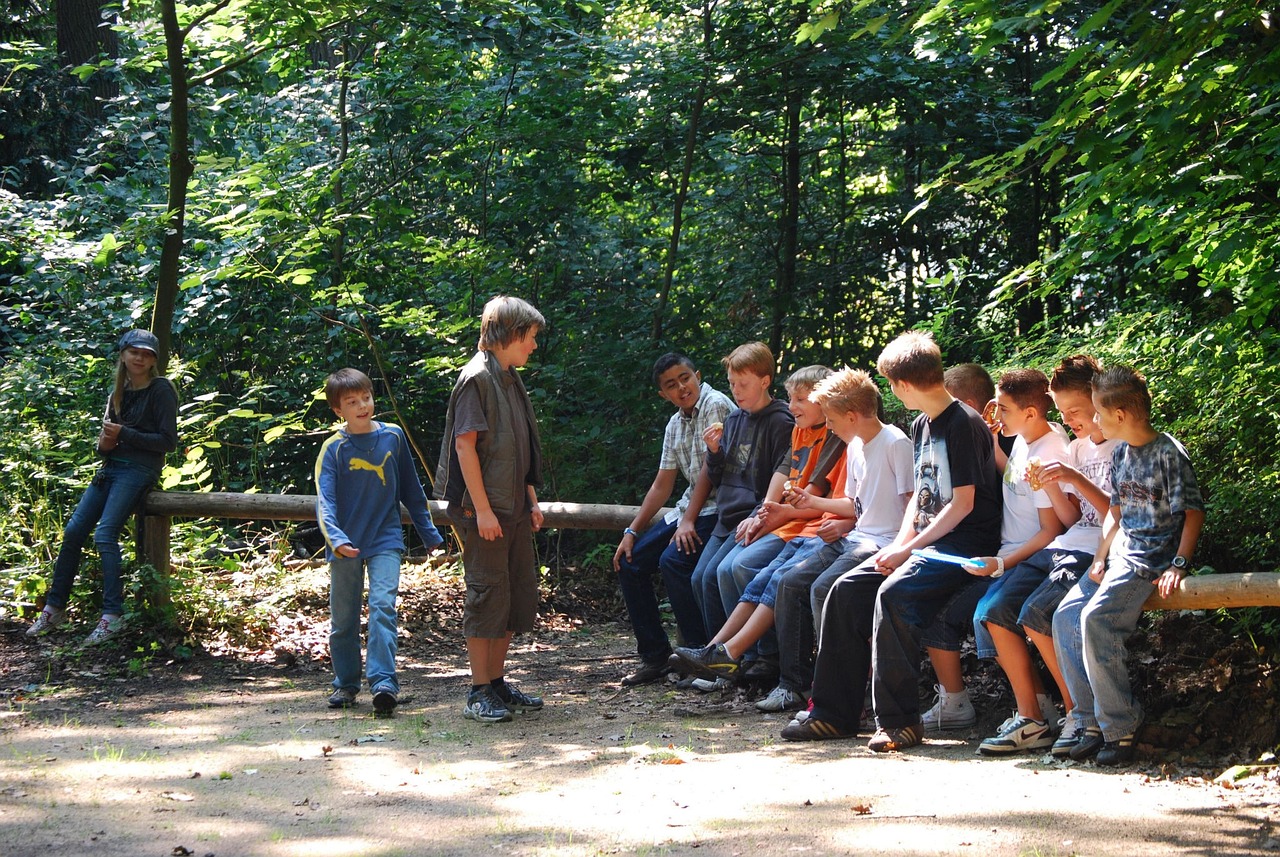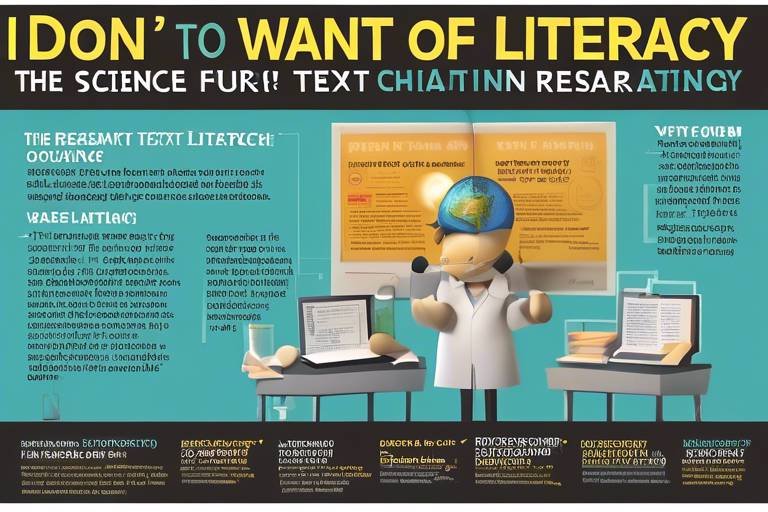Innovations in Research Methodologies for Youth Engagement
In today's rapidly evolving world, engaging the youth in research has become more vital than ever. With their unique perspectives and experiences, young people can offer invaluable insights that can shape policies and practices. However, traditional research methodologies often fail to capture their voices effectively. This article explores cutting-edge research methodologies that enhance youth engagement, highlighting innovative approaches, tools, and strategies that researchers can adopt to involve young people meaningfully in the research process.
Participatory Action Research (PAR) empowers youth by involving them directly in the research process. Imagine being a part of something bigger than yourself, where your voice matters! This approach fosters collaboration between researchers and participants, ensuring that the voices of young people are not just heard but are integral to the findings. By actively participating, youth can share their experiences and insights, shaping the research outcomes to better reflect their realities. This methodology not only enhances the relevance of the research but also builds a sense of ownership among young participants.
Digital storytelling is a fascinating blend of technology and narrative that captivates youth and draws them into research. Picture this: young people sharing their experiences through videos, podcasts, or interactive media. This approach allows researchers to capture rich qualitative data that reflects the diverse perspectives of young participants. By utilizing multimedia, researchers can present findings in a more engaging and relatable way, making the research not just informative but also impactful. Digital storytelling transforms the research process into a collaborative journey where youth can express themselves creatively.
Who said research has to be boring? Enter gamification, the innovative technique that introduces game elements into research methodologies. By turning participation into a fun and interactive experience, gamification motivates young people to contribute actively. Imagine answering survey questions as part of a game or completing challenges related to the research topic. This approach not only leads to richer data collection but also fosters a deeper connection to the subject matter. Gamification makes research feel less like a chore and more like an exciting adventure!
In the digital age, social media platforms have become powerful tools for researchers aiming to connect with youth. Utilizing these platforms allows researchers to reach a wider audience, facilitating real-time feedback and engagement. Think about it: where do young people spend a significant portion of their time? That's right—on social media! By tapping into these networks, researchers can gather valuable insights into the experiences and opinions of young people, making the research process more dynamic and relevant. Social media not only broadens the reach but also encourages open dialogue, creating a vibrant community around the research topic.
Visual methods, such as photography and art, enable youth to express their thoughts and feelings creatively. Imagine a young person capturing their emotions through a photograph or creating a piece of art that reflects their experiences. These techniques enhance engagement and yield unique data that traditional methods may overlook. Visual storytelling allows researchers to see the world through the eyes of young participants, providing a deeper understanding of their perspectives. By incorporating visual methods, researchers can enrich their findings and create a more inclusive research environment.
With the rise of smartphones, mobile surveys and applications offer a convenient way for youth to participate in research. These tools can significantly increase response rates, allowing researchers to capture the dynamic perspectives of young people in real time. Imagine being able to share your thoughts on a topic right from your phone while on the go! This convenience not only encourages participation but also helps researchers gather timely data, making the research process more agile and responsive to the needs of youth.
Conducting focus groups with youth advocates ensures that discussions are relevant and respectful. This method encourages open dialogue, allowing researchers to gain insights into the concerns and aspirations of young participants. When youth advocates are involved, the atmosphere becomes more inclusive, fostering trust and encouraging honest conversations. This collaborative approach not only enhances the quality of the data collected but also empowers young people to share their voices in a safe space.
Addressing ethical considerations is crucial when engaging youth in research. Understanding consent, confidentiality, and the power dynamics involved helps create a safe and respectful environment for young participants. Researchers must prioritize the well-being of youth, ensuring that their rights are protected throughout the research process. By establishing clear ethical guidelines, researchers can foster trust and build meaningful relationships with young participants, ultimately leading to more authentic and impactful research outcomes.
Longitudinal studies track changes over time, providing valuable insights into youth engagement trends. This methodology allows researchers to analyze the impact of interventions and understand the evolving needs of young people in various contexts. Imagine being able to follow a group of young participants over several years, witnessing their growth and the changes in their perspectives. Longitudinal studies offer a comprehensive view of youth engagement, revealing patterns and shifts that can inform future research and practice.
- What is the importance of youth engagement in research?
Engaging youth in research is crucial as it ensures that their perspectives are considered, leading to more relevant and impactful findings. - How can digital storytelling enhance research?
Digital storytelling allows youth to express their experiences creatively, providing rich qualitative data that traditional methods may miss. - What role does gamification play in research methodologies?
Gamification makes research participation more engaging and enjoyable, motivating youth to contribute actively. - Why are ethical considerations important in youth research?
Ethical considerations protect the rights and well-being of young participants, fostering trust and ensuring respectful engagement.

Participatory Action Research
Participatory Action Research (PAR) is not just a method; it’s a philosophy that transforms the way we approach research involving youth. Imagine a scenario where young people are not merely subjects of study, but active collaborators in the research process. This is the essence of PAR. It empowers youth by giving them a platform to voice their opinions, ideas, and experiences, making them integral to the research narrative. By fostering collaboration between researchers and participants, PAR ensures that the unique perspectives of young individuals are not only heard but also woven into the very fabric of the research findings.
The beauty of PAR lies in its cyclical nature. Researchers and youth work together through a series of phases: planning, acting, observing, and reflecting. This iterative process allows for continuous feedback and adaptation, making the research more relevant and impactful. For instance, a group of high school students might collaborate with researchers to address issues in their community. They would identify the problems, design the research, collect data, and analyze the results together, ensuring that the outcomes are meaningful and applicable to their lives.
One of the standout features of PAR is its emphasis on social change. It’s not just about gathering data; it’s about using that data to effect positive transformations in the community. By involving youth in the research process, PAR cultivates a sense of ownership and responsibility among young participants. They become advocates for change, armed with the knowledge and skills gained through their involvement. This can lead to initiatives that directly address the concerns they’ve identified, creating a ripple effect of empowerment and engagement.
Furthermore, the collaborative nature of PAR helps to break down traditional power dynamics often found in research settings. Researchers typically hold the authority, but in PAR, the roles are more fluid. This shift encourages open dialogue and mutual respect, fostering an environment where young people feel comfortable sharing their thoughts and experiences. The result? Richer data that captures the essence of youth engagement in a way that traditional methods often miss.
Incorporating PAR into youth research can also enhance the credibility and relevance of the findings. When young people are involved in the research process, the outcomes are more likely to resonate with their peers. This approach not only validates their experiences but also increases the likelihood that the research will be utilized in real-world applications. Researchers can gain insights that are not only profound but also actionable, leading to better-informed policies and programs tailored to the needs of youth.
In conclusion, Participatory Action Research is a powerful tool for engaging youth in meaningful ways. It creates an inclusive environment where young voices matter, fostering collaboration and social change. By embracing this innovative methodology, researchers can unlock a treasure trove of insights that not only enrich their studies but also empower the next generation of changemakers.

Digital Storytelling
Digital storytelling is a fascinating blend of technology and narrative that truly transforms the way young people engage with research. Imagine a world where the voices of youth are not just heard but celebrated through their own stories. This methodology empowers them to share their experiences, perspectives, and emotions in a format that resonates with their peers and researchers alike. By utilizing multimedia tools—such as videos, podcasts, and digital art—young participants can express themselves in ways that traditional research methods often overlook.
One of the most exciting aspects of digital storytelling is its ability to create a rich tapestry of qualitative data. When youth narrate their stories through their own lenses, they provide insights that are deeply personal and relatable. This not only enhances the authenticity of the research but also fosters a sense of ownership among participants. They become co-creators of knowledge rather than mere subjects of study, which is a powerful shift in the research paradigm.
Moreover, digital storytelling can serve as a bridge between generations. The stories shared by young people can resonate with older generations, creating a dialogue that fosters understanding and empathy. Think of it as a digital campfire where stories are shared, lessons are learned, and connections are made. This communal aspect can also enhance the impact of research findings, as they are grounded in real-life experiences that others can relate to.
Incorporating digital storytelling into research methodologies can be straightforward. Researchers can follow these key steps to ensure effective implementation:
- Training and Support: Provide training sessions for youth on how to use digital tools effectively. This ensures they feel confident in their storytelling abilities.
- Creating Safe Spaces: Establish an environment where participants feel comfortable sharing their stories. This could include community workshops or online platforms.
- Encouraging Creativity: Allow participants to express themselves in various formats—be it through video, audio, or visual art. The goal is to let their creativity shine.
The outcomes of employing digital storytelling in youth research are profound. Not only do researchers gain access to a wealth of qualitative data, but they also cultivate a deeper connection with the youth they are studying. This connection can lead to more meaningful interventions and policies that reflect the true needs and desires of young people.
In summary, digital storytelling is not just a research tool; it’s a movement that champions the voices of youth. By embracing this innovative approach, researchers can unlock a treasure trove of insights that enrich their work and empower young participants to take an active role in shaping the narrative of their own lives.

Gamification in Research
Gamification in research is not just a buzzword; it’s a transformative approach that breathes life into the often tedious process of data collection. Imagine turning a standard survey into an engaging game where participants earn points for their contributions. This method taps into the natural enthusiasm and competitive spirit of youth, making participation feel less like a chore and more like an adventure. By integrating game elements such as challenges, rewards, and feedback, researchers can create a vibrant environment that encourages young people to engage actively in the research process.
Why does this matter? Well, traditional research methodologies can sometimes alienate young participants. They may feel disconnected from the process, leading to disengagement and, ultimately, poor data quality. However, when researchers incorporate gamification, they create a bridge—a way to connect with youth on their level. This approach not only motivates them to participate but also fosters a sense of ownership over the research, allowing them to see their contributions as valuable.
Through gamified research, participants can experience:
- Increased Engagement: Game mechanics capture attention and maintain interest, leading to higher participation rates.
- Enhanced Data Quality: Engaged participants are more likely to provide thoughtful and accurate responses.
- Real-Time Feedback: Gamification allows for immediate feedback, helping participants understand their role in the research process.
Moreover, gamification can take many forms. For instance, researchers might develop interactive apps where participants can complete tasks related to the study. These tasks could range from simple quizzes to complex simulations that reflect real-world scenarios. The key is to design experiences that resonate with youth, making them feel like they are part of something larger than themselves.
One of the most compelling aspects of gamification is its ability to generate rich qualitative data. As young participants navigate through challenges, they often share insights, stories, and opinions that traditional methods might miss. This narrative-driven data can provide a deeper understanding of youth perspectives, enriching the overall findings of the research.
In conclusion, gamification in research is not just about making data collection fun; it’s about creating a collaborative space where youth feel empowered to share their voices. By embracing this innovative approach, researchers can unlock the potential of young participants, leading to more meaningful and impactful research outcomes. As we look to the future, it’s clear that gamification will play a pivotal role in how we engage with and understand youth.
- What is gamification in research?
Gamification in research refers to the integration of game elements into the research process to enhance engagement and participation among youth. - How does gamification improve data quality?
By making the research process more engaging, participants are more likely to provide thoughtful and accurate responses, leading to higher quality data. - Can gamification be applied to all types of research?
While gamification is particularly effective with youth, it can be adapted to various research methodologies depending on the target audience and objectives.

Social Media as a Research Tool
In today's digital age, social media has transformed the way we communicate, connect, and share information. For researchers, this shift presents a unique opportunity to tap into the vast pool of insights offered by young people who are active on various platforms. By utilizing social media as a research tool, researchers can engage with youth in real-time, gathering valuable data that reflects their thoughts, experiences, and opinions.
One of the most significant advantages of using social media in research is the ability to reach a wide audience. With millions of young people actively participating on platforms like Instagram, Twitter, and Facebook, researchers can easily disseminate surveys, polls, and discussion prompts to gather feedback. This approach not only increases participation rates but also ensures that the voices of diverse youth populations are represented. Imagine casting a net over a vast ocean of thoughts and ideas; social media provides that expansive reach.
Moreover, social media facilitates a more dynamic interaction between researchers and participants. Traditional research methods often involve rigid structures, but social media allows for a more fluid exchange of information. Researchers can post questions, share updates, and encourage discussions, creating an engaging environment where young people feel empowered to share their perspectives. This real-time feedback loop can lead to deeper insights and a richer understanding of the issues at hand.
When utilizing social media for research, it is essential to consider the various formats that can be employed to engage youth effectively. For instance, researchers can use
- Polls and Surveys: Quick and easy to respond to, allowing for immediate data collection.
- Discussion Threads: Encouraging open dialogue around specific topics, fostering community engagement.
- Live Q&A Sessions: Providing a platform for real-time interaction, where researchers can address questions and concerns directly.
However, while social media offers numerous benefits, researchers must navigate the challenges associated with this methodology. Issues such as privacy, consent, and the potential for misrepresentation of data are critical considerations. Researchers need to ensure that participants understand how their information will be used and that their identities remain confidential. Establishing clear guidelines and ethical standards is paramount to maintaining trust and respect within the research process.
In conclusion, social media stands out as a powerful research tool that can enhance youth engagement in meaningful ways. By embracing the possibilities that these platforms offer, researchers can create a more inclusive and representative research environment, ultimately leading to richer, more nuanced insights into the lives of young people. So, why not dive into the world of social media research? The potential for discovery is as vast as the digital landscape itself!
- How can researchers ensure ethical use of social media in their studies? Researchers should prioritize informed consent, maintain participant confidentiality, and provide transparency regarding data usage.
- What types of social media platforms are best for youth engagement? Platforms like Instagram, TikTok, and Snapchat are particularly popular among younger audiences, making them ideal for research outreach.
- Can social media data be considered reliable? While social media data can provide valuable insights, researchers must critically evaluate the context and authenticity of the information shared.

Visual Methods
When it comes to engaging youth in research, offer a fresh and exciting approach. Imagine a world where young people can express their thoughts and feelings not just through words, but through vibrant images, art, and creative storytelling. This methodology taps into the innate creativity of youth, allowing them to communicate their perspectives in ways that traditional methods often overlook. By using visual methods, researchers can uncover insights that might remain hidden in surveys or interviews.
Visual methods can take many forms, including photography, drawing, and video production. For instance, when young participants are asked to capture their daily lives through photographs, they provide a window into their world that is rich with context and emotion. These images can then be analyzed to reveal trends, challenges, and aspirations that resonate with their experiences. It’s like flipping through a photo album of their lives, where each picture tells a story that words alone might fail to convey.
One of the most compelling aspects of visual methods is their ability to foster engagement. When youth are invited to express themselves creatively, they often feel more invested in the research process. This sense of ownership can lead to deeper discussions and more meaningful contributions. For example, a project that combines art with community issues can empower young people to not only share their views but also to advocate for change. They become not just participants, but active agents in the research narrative.
Moreover, visual methods can bridge gaps between diverse groups. In multicultural settings, where language barriers might exist, visuals can serve as a universal language. A simple drawing or a photograph can evoke emotions and ideas that transcend linguistic limitations, making it easier for youth from different backgrounds to connect and share their experiences. This inclusivity is crucial in research, as it ensures that all voices are heard and valued.
Incorporating visual methods into research also encourages collaboration among participants. For instance, group projects where youth create a mural or a short film together can foster teamwork and build community. This collaborative spirit not only enhances the quality of the data collected but also enriches the participants' experience, making them feel part of something larger than themselves.
However, as with any research method, there are ethical considerations to keep in mind. It’s essential to obtain informed consent, especially when working with minors, and to respect the privacy of participants when sharing their visual creations. Researchers must navigate these waters carefully, ensuring that the process is empowering rather than exploitative.
In summary, represent a powerful tool in the arsenal of youth engagement strategies. They not only provide a platform for young people to express themselves creatively but also enhance the richness and depth of the data collected. By embracing these innovative approaches, researchers can tap into the unique perspectives of youth, fostering a deeper understanding of their lives and experiences.
- What are visual methods in research? Visual methods are research techniques that utilize images, art, and other creative forms of expression to engage participants and gather data.
- How do visual methods enhance youth engagement? They allow young people to express their thoughts and feelings creatively, fostering a sense of ownership and investment in the research process.
- Are there any ethical considerations when using visual methods? Yes, it is crucial to obtain informed consent and respect participants' privacy when sharing their visual creations.
- Can visual methods be used in multicultural settings? Absolutely! Visual methods can transcend language barriers, making them effective in diverse groups.

Mobile Surveys and Apps
In today's fast-paced world, the way we gather information is evolving, and are at the forefront of this transformation. Imagine being able to reach young people wherever they are, whether they’re lounging at home, commuting, or hanging out with friends. This is the beauty of mobile technology—it allows researchers to tap into the lives of youth in real-time, making data collection not just easier but also more relevant and immediate.
One of the significant advantages of mobile surveys is their convenience. Unlike traditional surveys that require participants to sit down with a pen and paper, mobile surveys can be completed on smartphones or tablets in just a few minutes. This ease of access encourages higher participation rates, particularly among youth who are constantly on the go. Additionally, researchers can design surveys that are visually appealing and interactive, which can significantly enhance the user experience. Think of it as turning a mundane task into an engaging activity—like playing a game rather than doing homework!
Moreover, mobile apps can offer a range of functionalities that traditional methods simply can't match. For instance, researchers can incorporate
- Real-time feedback: Participants can share their thoughts and experiences instantly, which provides researchers with immediate insights.
- Multimedia elements: Surveys can include videos, images, and audio clips, allowing for a richer data collection process.
- Location-based services: Apps can gather data based on where participants are, adding another layer of context to the research.
Another exciting aspect of mobile surveys is their ability to foster ongoing engagement. Rather than a one-off interaction, researchers can use apps to create a continuous dialogue with young participants. Imagine a scenario where youth can provide feedback on a project over several months, allowing researchers to track changes in opinions and behaviors over time. This dynamic interaction can lead to deeper insights and a more profound understanding of youth engagement.
However, while the benefits are plentiful, researchers must also be mindful of the challenges that come with utilizing mobile surveys and apps. Issues such as data privacy, accessibility, and digital literacy must be addressed to ensure that all youth can participate meaningfully. It’s crucial to create an inclusive environment where every voice is heard, regardless of their technological capabilities.
In conclusion, mobile surveys and apps represent a revolutionary shift in how researchers can engage with young people. By leveraging technology, researchers can gather timely, relevant, and rich data that reflects the true experiences and opinions of youth. As we continue to explore innovative methodologies, it’s clear that the future of youth engagement in research is not just bright—it’s mobile.
Q: What are mobile surveys?
A: Mobile surveys are questionnaires that can be completed on smartphones or tablets, allowing researchers to gather data conveniently and efficiently.
Q: How do mobile apps enhance youth engagement?
A: Mobile apps can provide interactive features, real-time feedback, and multimedia content, making participation more engaging for young people.
Q: What challenges do researchers face when using mobile surveys?
A: Researchers must consider issues like data privacy, accessibility, and digital literacy to ensure inclusive participation from all youth.

Focus Groups with Youth Advocates
Focus groups with youth advocates are a transformative approach that not only elevates the voices of young participants but also enriches the overall research process. By involving youth advocates—individuals who are passionate about representing the interests and concerns of their peers—researchers create a dynamic environment where open dialogue can flourish. This method encourages participants to share their thoughts freely, fostering a sense of trust and respect that is crucial for meaningful engagement.
Imagine a roundtable discussion where young people feel empowered to express their views without fear of judgment. This is the essence of focus groups with youth advocates. Not only do these advocates help facilitate conversations, but they also bridge the gap between researchers and participants, ensuring that the discussions remain relevant and sensitive to the needs of the youth involved. By leveraging their unique insights and experiences, youth advocates can guide researchers towards understanding the pressing issues that matter most to their peers.
In these focus groups, researchers can explore a myriad of topics, such as mental health, education, community involvement, and social justice. The discussions can be structured around key questions, allowing participants to delve deep into their personal experiences. For instance, a focus group might revolve around the following themes:
- Barriers to Engagement: What prevents young people from getting involved in community activities?
- Digital Influence: How do social media platforms impact youth engagement and activism?
- Support Systems: What resources do young people need to feel empowered and supported?
By concentrating on these themes, researchers can gather rich qualitative data that reflects the authentic voices of young people. Furthermore, the presence of youth advocates ensures that the discussions remain respectful and inclusive, allowing every participant to feel valued and heard. This collaborative approach not only enhances the quality of the data collected but also fosters a sense of ownership among the participants, making them feel like integral parts of the research process.
However, it’s essential for researchers to approach these focus groups with a clear understanding of ethical considerations. Ensuring confidentiality and obtaining informed consent are paramount to creating a safe environment for all participants. Researchers should also be mindful of the power dynamics at play, ensuring that youth advocates are not only facilitators but also equal participants in the conversation.
In conclusion, focus groups with youth advocates represent a powerful methodology for engaging young people in research. By prioritizing open dialogue, respect, and collaboration, researchers can gain invaluable insights into the lives and perspectives of youth, ultimately leading to more impactful and relevant findings. This approach not only benefits the research but also empowers young participants to become active contributors to the conversations that shape their futures.
1. What is the purpose of involving youth advocates in focus groups?
Involving youth advocates helps ensure that the discussions are relevant, respectful, and reflective of the actual experiences and concerns of young people. Advocates can facilitate conversations and encourage participation, making the research process more inclusive.
2. How do researchers ensure ethical practices in focus groups with youth?
Researchers must prioritize informed consent, confidentiality, and respect for all participants. It is crucial to create a safe environment where young people feel comfortable sharing their thoughts and experiences.
3. What topics can be discussed in focus groups with youth advocates?
Topics can vary widely, including mental health, education, community engagement, and social justice. The key is to focus on issues that resonate with the participants and reflect their lived experiences.

Ethical Considerations in Youth Research
When diving into the realm of youth research, it's crucial to navigate the waters of ethical considerations with care and precision. Engaging young participants in research isn't just about collecting data; it’s about respecting their rights, voices, and experiences. After all, these young individuals are not merely subjects; they are partners in the research journey. So, what are some key ethical principles that researchers should keep in mind?
First and foremost, informed consent is paramount. Researchers must ensure that young participants, and their guardians when necessary, fully understand the nature of the research, what their involvement entails, and any potential risks. This means using language that is clear and accessible, avoiding jargon that might confuse or mislead. Imagine trying to explain a complex concept to a friend who knows nothing about it; that’s the level of clarity you should strive for.
Next, confidentiality is another critical aspect. Young people should feel safe sharing their thoughts and experiences without the fear of their information being exposed. This involves implementing robust measures to protect their identities, such as anonymizing data and securely storing information. Think of it like a secret club where only members know the inner workings; the same principle applies to youth research.
Moreover, researchers must be aware of the power dynamics at play. Often, adults hold more power in research settings, which can inadvertently silence young voices. To counteract this, it's essential to create an environment where young participants feel empowered to share their views openly. This could involve using youth advocates or facilitators who can bridge the gap between researchers and participants, ensuring that discussions are respectful and relevant.
Another ethical consideration is the potential for emotional impact. Research topics may touch on sensitive areas that could evoke strong feelings or memories in young participants. Researchers should be prepared to provide support and resources, ensuring that participants have access to counseling or debriefing sessions if necessary. It's about creating a safety net, so they don’t feel like they’re jumping into the deep end without a life jacket.
Lastly, researchers should be mindful of the benefits and burdens of participation. It’s essential to weigh the potential gains of the research against any possible negative impacts on young participants. Researchers should ask themselves: Is this research truly beneficial to the youth involved? Are we giving back to the community in a meaningful way? Ensuring that there are tangible benefits for participants can help mitigate any ethical concerns.
In conclusion, ethical considerations in youth research are not just a checklist to tick off; they are a fundamental part of building trust and ensuring meaningful engagement. By prioritizing informed consent, confidentiality, power dynamics, emotional impact, and the benefits of participation, researchers can create a respectful and effective research environment that empowers young voices.
- Why is informed consent important in youth research?
Informed consent ensures that participants understand what the research involves and agree to participate voluntarily, which is crucial for ethical integrity. - How can researchers protect the confidentiality of young participants?
Researchers can anonymize data, securely store information, and limit access to sensitive data to protect participants’ identities. - What should researchers do if a participant feels uncomfortable during the study?
Researchers should have protocols in place to provide support, including access to counseling or the option to withdraw from the study at any time.

Longitudinal Studies for Youth Engagement
When we think about understanding the ever-evolving landscape of youth engagement, longitudinal studies emerge as a powerful tool. Unlike traditional research methods that capture a snapshot in time, longitudinal studies allow researchers to track changes over extended periods. This means that researchers can observe how young people's attitudes, behaviors, and engagement levels shift in response to various interventions and societal changes. Imagine trying to capture the growth of a tree by taking a picture of it once a year; you might see its height, but you won't understand its health, the conditions it thrives in, or the challenges it faces throughout the seasons. Similarly, longitudinal studies offer a comprehensive view of youth engagement that can lead to more effective strategies and interventions.
By conducting these studies, researchers can delve into critical questions such as:
- How do young people's interests change as they transition from adolescence to adulthood?
- What external factors influence their engagement in community activities over time?
- How do specific programs impact youth engagement levels in different contexts?
These questions are not just academic; they resonate deeply with policymakers, educators, and community leaders who seek to foster environments where young people can thrive. For instance, a longitudinal study might reveal that a particular youth program significantly boosts engagement during the summer months but sees a drop-off during the school year. This insight can lead to targeted interventions that keep young people engaged year-round.
Furthermore, longitudinal studies can help identify trends and patterns that might not be visible in cross-sectional studies. Researchers can analyze data from multiple points in time, allowing them to see the trajectory of youth engagement. For example, they might discover that participation in extracurricular activities leads to increased civic engagement in later years, highlighting the importance of supporting such programs in schools.
However, conducting longitudinal studies is not without its challenges. It requires a significant investment of time and resources, as researchers must maintain contact with participants over the years. There’s also the risk of attrition, where participants drop out of the study, potentially skewing the results. To mitigate this, researchers often employ strategies such as regular check-ins, incentives for participation, and creating a sense of community among participants.
In conclusion, longitudinal studies are invaluable for understanding youth engagement. They provide a dynamic view of how young people interact with their environments and how their engagement evolves over time. By harnessing the insights gained from these studies, stakeholders can implement more effective programs and policies that resonate with the needs and aspirations of youth. As we move forward, embracing this methodology will be crucial in creating meaningful opportunities for young people.
Q: What are longitudinal studies?
A: Longitudinal studies are research methods that involve repeated observations of the same variables over long periods. They help researchers understand how and why changes occur over time.
Q: Why are longitudinal studies important for youth engagement?
A: They provide insights into how youth engagement evolves, allowing for the identification of trends and the effectiveness of interventions over time.
Q: What challenges do researchers face with longitudinal studies?
A: Challenges include maintaining participant engagement, managing resources, and dealing with potential attrition of participants over time.
Q: How can longitudinal studies influence policy-making?
A: By providing evidence of the long-term impacts of programs, these studies can guide policymakers in developing more effective youth engagement strategies.
Frequently Asked Questions
- What is Participatory Action Research (PAR)?
Participatory Action Research (PAR) is a collaborative approach that empowers youth by involving them directly in the research process. It emphasizes the importance of their voices and experiences, ensuring that the findings reflect their perspectives and needs.
- How does digital storytelling enhance youth engagement?
Digital storytelling combines technology with personal narratives, allowing youth to express their experiences through multimedia. This method not only engages them more deeply but also provides researchers with rich qualitative data that captures their unique perspectives.
- What is gamification in research, and why is it effective?
Gamification involves incorporating game-like elements into research methodologies to make participation more enjoyable for youth. By adding fun and interactive components, it motivates young people to engage actively, leading to richer data collection and a stronger connection to the topic.
- How can social media be utilized as a research tool?
Researchers can use social media platforms to reach a broader audience of youth, facilitating real-time feedback and engagement. This approach provides valuable insights into the opinions and experiences of young people, making the research process more dynamic and relevant.
- What are visual methods, and how do they benefit youth research?
Visual methods, such as photography and art, allow youth to express their thoughts and feelings creatively. These techniques enhance engagement and yield unique data that traditional research methods might overlook, offering a richer understanding of their experiences.
- Why are mobile surveys and apps important for youth engagement?
Mobile surveys and applications provide a convenient way for youth to participate in research. They can increase response rates and allow researchers to gather timely data, capturing the dynamic perspectives of young people more effectively.
- What role do focus groups with youth advocates play in research?
Focus groups with youth advocates encourage open dialogue and ensure discussions are relevant and respectful. This method allows researchers to gain deeper insights into the concerns and aspirations of young participants, fostering a supportive research environment.
- What ethical considerations should be taken into account in youth research?
When engaging youth in research, it's crucial to address ethical considerations such as consent, confidentiality, and power dynamics. Understanding these factors helps create a safe and respectful environment for young participants, ensuring their rights and voices are protected.
- What are the benefits of conducting longitudinal studies in youth engagement?
Longitudinal studies track changes over time, offering valuable insights into youth engagement trends. This methodology allows researchers to analyze the impact of interventions and understand the evolving needs of young people in various contexts, providing a comprehensive view of their experiences.


















